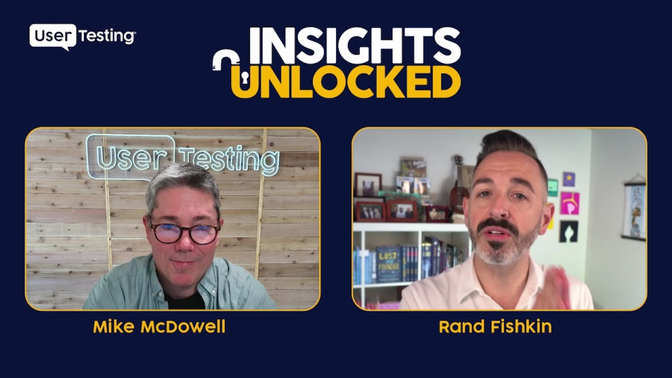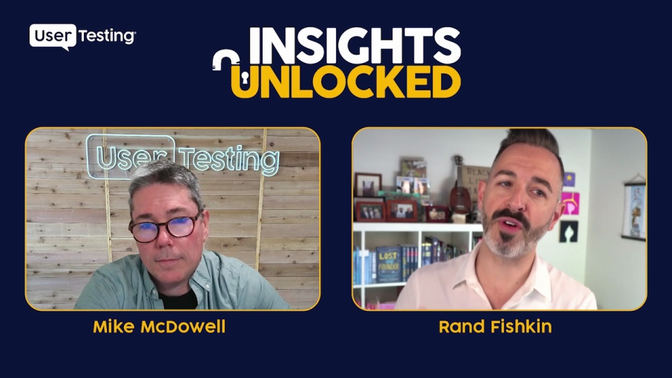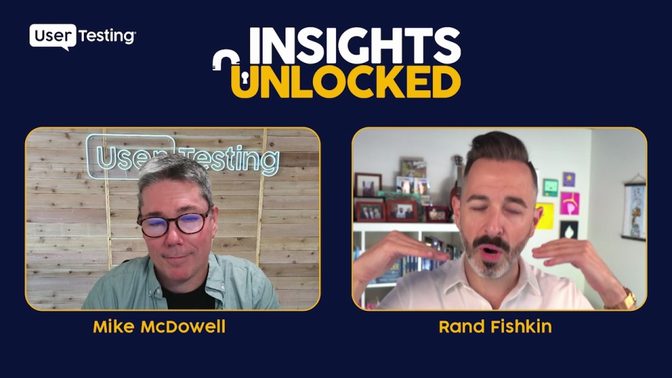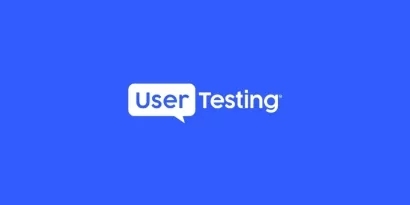
Episode 177 | June 30, 2025
Winning at zero-click marketing starts with customer empathy
Rand Fishkin breaks down the death of attribution and how zero-click marketing and customer empathy is reshaping digital strategy
Winning at zero-click marketing starts with customer empathy
The ground is shifting beneath marketers’ feet—and many haven’t even realized it yet.
If you’ve been relying on attribution modeling to justify your marketing efforts, Rand Fishkin has a clear message for you: it’s time to rethink everything. In a recent episode of Insights Unlocked, the SparkToro co-founder and longtime marketing truth-teller sat down with UserTesting’s Mike McDowell to unpack the demise of attribution, the rise of zero-click marketing, and how to actually understand customer behavior in a data-restricted world.
This episode wasn’t just about changing tactics—it is a call to rewire how we think about success in marketing. Let’s dive into what’s behind the death of attribution and why empathy and behavioral insight are becoming marketers' new competitive edge.

Attribution modeling is broken—and it’s not coming back
For the last couple of decades, marketers believed they could trace every conversion back to a source. That belief fueled massive investment in platforms that promised trackable ROI. But as Rand explains, that era is effectively over.
“Anyone who tells you that they have sophisticated AI tools that will let you do [organic attribution modeling] is lying to you,” he said. “They are lying to you to sell you something.”
The reason? Major platforms have stopped passing referral data. Privacy regulations, the deprecation of third-party cookies, the rise of ad blockers, LLM-generated quick answers, and platform walled gardens have all contributed to this data blackout. The result is that marketers are flying blind when it comes to understanding how content impacts their funnel—particularly at the top and middle stages.
Attribution modeling is now little more than a relic. As Rand put it bluntly: “Attribution is dead.”
ON-DEMAND WEBINAR
Tactical (and practical) tips to get fast feedback for better marketing
Welcome to the zero-click marketing reality
If attribution is dead, what’s the alternative?
Marketers are now operating in a world dominated by zero-click marketing. Instead of driving audiences to a website or landing page, the goal is to provide value natively within platforms like LinkedIn, TikTok, YouTube, or Reddit—where your audience already spends their time.
“Marketing of the 21st century is going to look a lot more like marketing of the 20th century,” Rand said. “Create influence in the places people pay attention, and measure based on lift, not attribution.”
That shift means adapting your content for platform algorithms that prioritize engagement over outbound clicks. It also requires letting go of metrics like click-through rate and focusing instead on signals of influence—comments, shares, follower growth, brand sentiment, and yes, the old-school tactic of watching regional sales lift after launching a campaign.

From brand lift to behavior data: redefining marketing measurement
If we can’t rely on referral data or last-click attribution, how do we measure what’s working?
Rand recommends borrowing from an old playbook. “You’re going to have to stop measuring with attribution,” he explained. “You’re going to have to start measuring the same way Coca-Cola measured billboards in 1955… You test and measure investments.”
This is where brand lift becomes a primary performance indicator. It’s not about tracking every visitor—it’s about observing how your presence in specific platforms or communities changes customer behavior over time.
And it’s also why tools like SparkToro and UserTesting are becoming increasingly valuable. SparkToro reveals audience behavior patterns—what podcasts they listen to, which YouTube channels they follow, what subreddits they engage in—while UserTesting enables direct, real-time feedback for your targeted audiences.
Together, they offer a powerful combo: behavior data and customer insight. Or as Rand put it, “These two things are valuable on their own and invaluable together.”
Empathy over dashboards: the new marketer’s mindset
It’s tempting to view marketing success as a numbers game. But Rand emphasized that understanding your audience requires more than a spreadsheet.
“The heart of building something people want and selling it to them in a way they’ll engage with is empathy,” he said. “That’s understanding who they are, what they do, and why they do it.”
Empathy fuels better creative, better messaging, and smarter product decisions. But it also means stepping out from behind dashboards and engaging with real users.
SparkToro recently redesigned its platform after conducting user interviews with DemandMaven’s Asia Orangio. The result? A new product experience that led to SparkToro’s most successful month in over two years. No additional marketing spend. Just listening, observing, and acting on real customer behavior.
“We built the product our customers actually needed—and it made a huge difference,” Rand said.
Why watching behavior sometimes beats just asking questions
One key insight Rand shared is that direct user interviews—while valuable—often only tell part of the story. Users may forget what led them to a decision or unconsciously omit critical steps in their journey.
That’s why observing behavior is so powerful.
“When we look at the URL journey, we see they actually visited three other providers… looked at Pinterest boards, subreddits,” Rand explained. “They didn’t even remember they did those things.”
SparkToro’s data is powered by aggregated clickstream behavior, providing a window into real browsing patterns. Combined with tools like UserTesting—which let you observe users interacting with your site or product—marketers can get a full picture of what customers do, not just what they say.
The real reason SparkToro's relaunch succeeded
Rand and his co-founder Casey didn’t just guess what features to add—they let customer behavior guide them.
Asia’s research revealed a surprising trend: many SparkToro users weren’t just finding media outlets or social influencers—they were using SparkToro to build internal pitches. Marketing teams needed visual, easy-to-share audience insights to convince their bosses and stakeholders.
The team responded by making SparkToro more “screenshotable,” prioritizing graphs, charts, and clear visual storytelling. They also added natural language audience queries so users could describe their audience conversationally—like they would to a colleague.
The results were impressive. SparkToro saw its highest growth in years—not through more ads, but by solving the right problems for its users.

Final thoughts: empathy is the new growth strategy
Rand’s perspective isn’t about throwing away marketing fundamentals—it’s about evolving them. As platforms tighten control and data dries up, human insight, behavioral research, and empathy are the keys to staying relevant and impactful.
Whether you're a content marketer watching your traffic drop or a product leader trying to prioritize features, the lesson is clear: stop guessing. Start listening.
And as Rand reminded us with a nod to both strategy and heart, “Empathy is the most powerful tool we have in building and marketing anything.”









